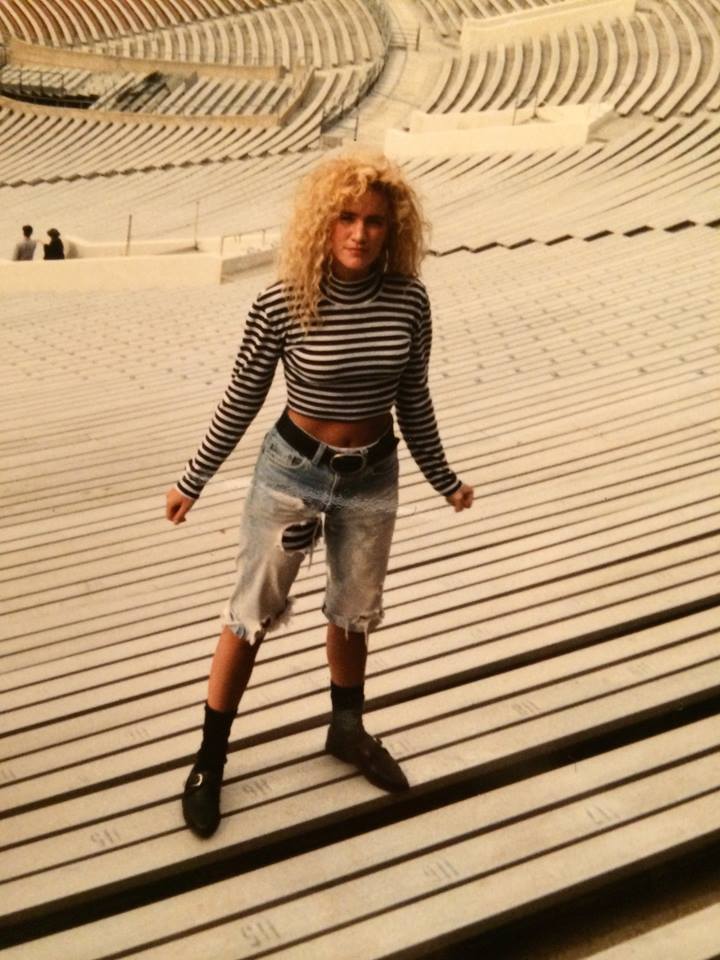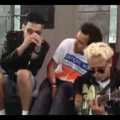
Imagine being 17 and getting a call from your favourite band in the world to invite you on tour. A bus arrives and you hop in for a hell of a trip, ditching your high school grad and prom because this is the dream. Hanging out with pals, dancing on the highway, yelling out every lyric at multiple shows across the country, and party after party after party. But that's when most people would wake up because this could only possibly be a fantasy. But for eight teens in 1988, this reverie was very much real.
It's no coincidence fans are the first faces shown in 101. The camera pans, showing fans screaming, donning crop tops, black clothes, and huge earrings; everyone burning for Depeche Mode to reveal themselves on stage. With their 1987 album Music for the Masses behind them (30 years old this week), Mode's intoxicating blend of melancholy and melody had never been stronger. It was critically lauded even by their earlier synthpop haters. Mode invited Pennebaker to document their 1988 American tour leading up to a Concert for the Masses show at the Rose Bowl outside of L.A.—the biggest of their career—but fans, not the stadium show gamble or music, ultimately convinced Pennebaker to join in.
"My strongest sense of something being there was the way the audience responded to them," Pennebaker said in 1989. "They weren't just people out for rock 'n' roll and a beer in the afternoon. It was as if they didn't go to any other concerts but this one."
Depeche Mode knew it too. Three weeks into filming, their camp pitched the directors on a risky idea: a dance contest to bring a busload of fans along for the ride—New York to California along Route 66. "We've all been saturated with the kind of voyeurism that reality TV has spewed for more than two decades," former Depeche Mode member Alan Wilder reflected in 2014, "but in 1988 this was an unusual and precarious approach." Thousands of Mode fans were told to "dress for the movies" and lined up to get into contest ground zero: Club Malibu in Lido Beach, New York. An 18-year-old Jay Serken summed up their place in 101 well in 1989: "To show what some of DM's fans are like, have fun, show the concept of the tour, promote the band, get drunk, throw up and… PARTY!!!!"
Saluting the camera with a sailor's hat, smile, and black-and-white checkered shorts, Christopher Hardwick was definitely one of the standouts cherry-picked from Club Malibu's packed floor. Even today, Hardwick still lights up like that 18-year-old talking about the band. "Depeche Mode were ultra cool. You [prided] yourself on being different and ahead of the curve by being a fan," Hardwick says on a call from New York City. "Wow, a bunch of people that have really cool haircuts, wear eyeliner and wear all black? These are my people. They facilitated that acceptance."

Liz Lazo, at 18, also landed her "audition" with a bright red pixie cut and black hat emulating Mode songwriter Martin Gore. Unlike most teens on a mission to win, she just happened to be at Club Malibu on a night out. "Someone told me 'Depeche Mode is doing a film and people are chosen to say why they like the band.' I was like, 'Okay, why not do it?'" Lazo recalls, speaking from New York City. "A week later, right after I graduated high school, I got a call from management saying. 'Girl, pack your bags, you're leaving next week!' What?!"
So began the "why not" chorus of the 101 bus kids: Christopher Hardwick, Liz Lazo, Oliver Chesler, Sandra Fergus, Mia Decaro, Jay Serken, Chris Parziale, and Maggie Mouzakitis—teen strangers who became family on a hormonal trip across America covering Mode shows around Pittsburgh, Arizona, and Pasadena.
Chesler was 17 at the time, skipping his own high school grad and prom for the ride with his first love Fergus. His signature mohawk and dark eyeshadow throughout 101 makes Depeche Mode's wardrobe look like Sunday school. "They gave us a thick book typed on a typewriter of the whole itinerary: everywhere we went, what we were going to eat that day," he says from his current home of Berlin. "But there was this guy Marcel in charge of our food budget and they would just spend it all on beer!"
Compared to today's reality show casts who walk in on day one with a catchphrase, 101 is a refreshingly honest portrait of being a teen. They smile over spilled beer, freely talk about barfing, pissing, and the smell of the bus at its air-conditioner-is-broken worst, help each other bleach their hair between shows, moon the camera, and roll hotel room joints. It's incredibly unsexy, however, their confidence in being nothing but themselves steals the show. "We played a lot of music. We barely slept on the bus. We'd stay up however long we drove doing tequila shots," Hardwick says. "It was just two cameramen trying to catch everybody's lives. It wasn't directed like 'You need to be more like this,' but 'So-and-so is having trouble picking out an outfit, let's go there.'"
Lazo says being filmed was weird at first, but given it was hardly the craziest part of the trip, she stopped caring. In one scene, Depeche Mode's performance of seething Music for the Masses highlight "Nothing" is paired with the teens' bus karaoke party version. Lazo confidently sings into the camera before literally bending over backwards to dance. "Yeah, I was like a gymnast back in the day," Lazo laughs. "Then Chris got on top of me with his legs—god! That was definitely one of those episodes where we had a bit to drink."

Soon enough, both Depeche Mode and teens start talking to the camera like it's a friend pre-reality show confessional booth. During a bus party packed with band and crew members, Serken declares to the camera "This is my thirteenth beer! And I'm still walking!" As mohawked couple Chesler and Fergus tease each other, Fergus turns to one camera: "I hate him. I really do." Mode frontman Dave Gahan even gets into it backstage. "I'm not sure about this at all," he tells the camera half-jokingly before their Rose Bowl set. "Let's go back to the hotel… they won't mind." But the show must go on.
Depeche Mode's stagecraft is the only part of 101 that can rival their teen fans' charisma. Once again, 101 pans over screaming Mode fans, fist-pumping in time to the ominous piano interlude "Pimpf." When the synth pulse of "Behind the Wheel" hits, the bus kids immediately start jumping, shrieking as Mode's veil drops. Dressed in white against the darkness is Gahan in a Jesus Christ pose, manically spinning, leaping, and coaxing his choir. Here is the transition from human to mythic Depeche Mode, servant to master over a sea of Americans who gave them overseas success.
"It was the most exhilarating thing on earth. It was so incredible to be front and centre, all dressed up in our VIP badges. They were playing all our songs," Hardwick remembers fondly. "When the gongs came in and the crescendo was building we screamed. I felt like a girl at a Beatles concert in the 60s!" The Beatles' iconic Shea Stadium show in 1965 drew more than 55,000 fans. Mode's Concert for the Masses at the Rose Bowl in 1988 thrilled more than 60,000.
From the 101 era on, everything changed for Mode. "That tour and that film was so important, especially for the perception of the band," Gore said in 2003. "We'd always been on the brink, especially in America but that 1988 tour was the first time the band really took off." Mode's voracious live following cemented their legacy, helping their music climb the Billboard charts upon the release of Mode's Music for the Masses follow-up Violator in 1990. Something else marked the dawn of the 90s: the debut of MTV's The Real World in 1992.

Backstage and at after parties to come, the bus teens were treated like stars, hanging out with Mode as peers and seeing Bono, Axl Rose, and Rick Astley. While memories of surrounding California nights blur together, Chesler has an off-camera party story for the books: "They took us to a club in L.A., and to get in, you had to have this skeleton earring clip-on. So we were these kids with skeleton earrings, and when we got there, girls—completely naked—were serving drinks. I don't even know what was going on in the roped-off part. Even to this day, I've never been in a place like this."
Chesler, Hardwick, and Lazo all point to The Real World as the first of many echoes of 101. Sure, if you want to go all "well actually," the first technical reality show was a 1973 documentary series on the average household calledAn American Family. But Depeche Mode 101 differed and set a reality show precedent by portraying these teens' lives not as a documentary but as a movie, casting them on a joyride with one of the coolest S&M-winking subversive bands of the 80s that follows puking lows as much as backstage highs. It's entertainment by design, the blueprint of our reality obsessions today for better or for worse.
A cikk eredetije még több képpel itt található.



